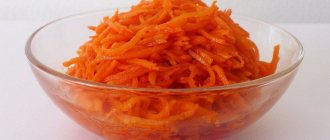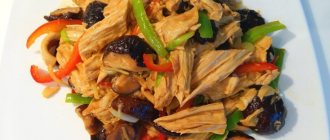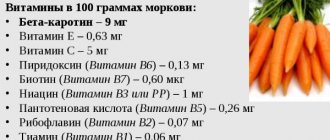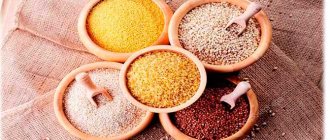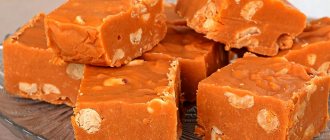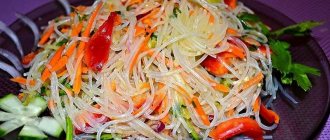general description
Morkovcha, as carrots are also called in Korean, is the most popular dish in Russia with East Asian roots. Not only does it taste good, it also contains many useful substances.
Carrots are not subject to heat treatment; to prepare it, just take a fresh root vegetable, grate it and mix with the marinade. The marinating solution contains sunflower oil and a variety of spices. The choice of oil is individual.
After a while, the salad turns out to be a little spicy in taste. There are no analogues to the Russian recipe for the dish.
Which consumption method should you choose?
In the process of getting rid of extra pounds, carrots can be eaten in any form. It can be used as an additive to various dishes or consumed as an independent component.
Nutritionists assure that carrots that have not been subjected to heat treatment are most useful for weight loss, since some beneficial microelements are lost when exposed to high temperatures. To achieve results in the shortest possible time, it is recommended to eat fresh and Korean carrots, as well as drink vegetable-based juices.
The best diet recipes
To lose a few extra pounds and get slimmer thighs, you don't have to eat only carrots. You can use it to prepare many different dishes that will help reduce the amount of fat:
- salad with pomegranate and apple. Necessary components: carrots (6 pcs.), 3 tbsp. pomegranate seeds, a glass of pomegranate juice, a granny apple. Grate the carrots and apple, add a little olive oil and pomegranate juice to the resulting mixture. Finally, garnish the salad with pomegranate seeds;
- with shrimps . For preparation you will need: 400 g carrots, 200 g shrimp, lemon juice, spices. Grate the carrots, add boiled chopped shrimp to it. Finally, season the salad with lemon juice, add ground red pepper and cinnamon;
- carrot and beet salad . To prepare you need 1 carrot, beetroot and black radish. All ingredients need to be finely chopped, and finally add grated garlic and parsley to the salad. If desired, the salad can be seasoned with a spoon of olive oil.
Carrot diet
There are several ways to lose weight using this vegetable. One of the most effective is the carrot mono-diet. Its duration is 3 days. During this time, you are allowed to eat only carrot salad and drink 2 liters of water daily.
Salad recipe: grated carrots, apple, olive oil and lemon juice. It is recommended to eat the salad 5 times a day, the volume of one serving is 220 g. On the second day, instead of an apple, you can use kiwi, and on the third, add some raisins to the salad.
It is important to know ! This method of losing weight is strictly contraindicated for patients with gastrointestinal diseases.
Benefits of the dish
This dish retains all its beneficial properties, because there is no heat treatment during preparation. Korean carrots contain many vitamins and minerals, but this is not the only positive quality.
- Gastrointestinal system . Normalizes intestinal function, accelerates metabolism and increases appetite. Ideal for a person suffering from constipation.
- Vision. Carrots contain carotene, which improves vision. Indicated for use by office workers who spend most of the day in front of a computer and those whose activities involve eye strain.
- Vascular diseases. Prevents diseases of the heart and blood vessels. Contains B vitamins. Contains vitamin PP, which dilates blood vessels.
- Prevention of acute respiratory infections. Helps avoid seasonal colds due to the presence of garlic in the composition.
- Teeth and skin. Gives skin a healthy color and strengthens teeth.
- Diet. For those who adhere to a limited diet, carrots are indispensable. Its calorie content is low and its fiber content is impressive. If you follow the carrot diet, you can lose 5 kilograms in 10 days.
In addition, the dish has diuretic and choleretic properties, is a good antiseptic and helps in the fight against various viruses. Korean carrots can restore metabolism and are used as an expectorant during colds. Helps in the fight against helminthiasis.
Dietary recipes with Korean carrots
We suggest using a recipe for Korean diet carrots without sugar, with a small amount of vegetable oil. Combine the snack with other foods to create delicious and healthy meals.
Ingredients:
- carrots - 1 kg;
- garlic - 3 cloves;
- salt - 25 g;
- Fitparad sugar substitute – 4 sachets;
- apple cider vinegar - 25 ml;
- ground coriander - 20 g;
- ground chili pepper - 1 tsp;
- olive oil - 20 g.
KBZHU ready dish per 100 g:
- calorie content - 51.92;
- proteins - 1.48;
- fats - 1.93;
- carbohydrates -7.63.
Preparation:
- Wash the carrots and remove the skin with a vegetable peeler. Grind on a Korean carrot grater. Place in a deep bowl, add salt, pepper, coriander, and sweetener.
- Stir and pour in vinegar. Leave for 20 minutes so that the carrots release their juice.
- Add the pressed garlic and season with olive oil.
- Transfer the salad to a container with a lid and place in the refrigerator to steep for 5-6 hours. Shelf life: 2 weeks.
Chicken salad
This dish will appeal to those who prefer hearty salads that replace a full meal. Pickled cucumber will add piquancy.
Ingredients:
- homemade Korean carrots - 300 g;
- chicken fillet - 200 g;
- hard low-fat cheese - 100 g;
- pickled cucumber - 3 pcs.;
- sour cream 10% - 2 tbsp. l.;
- parsley, dill - to taste.
Preparation:
- Boil the poultry until tender, cut into cubes or strips.
- Finely chop the cucumbers into strips and grate the cheese.
- Wash and chop the greens.
- In a deep container, mix the salad ingredients and season with sour cream.
- When serving, garnish with parsley.
Advice. Add salt to taste as Korean carrots are already salty.
Bean salad
This salad perfectly fills you up, eliminating the feeling of hunger for a long time.
Ingredients:
- chicken fillet or turkey ham - 300 g;
- Korean carrots - 200 g;
- boiled white beans - 150 g;
- green onions - to taste;
- olive oil - 1 tbsp. l.
Preparation : disassemble the boiled fillet into fibers (cut the ham into cubes), mix with carrots, beans, chopped onions and season with olive oil.
Apple salad
A sour, crisp apple will add a refreshing and juicy note to this salad.
Ingredients:
- tomatoes - 3 pcs.;
- Korean carrots - 200 g;
- apple - 1 pc.;
- parsley - to taste;
- olive oil - 1 tbsp. l.
Preparation : peel the apple, remove the seeds, chop into strips. Cut the tomatoes into large pieces. Mix all ingredients in a bowl, add chopped herbs and season with vegetable oil.
Corn and raisin salad
This dish combines the savory flavor of Korean carrots with the sweetness of raisins.
Ingredients:
- boiled chicken fillet - 300 g;
- boiled corn grains - 100 g;
- Korean carrots 200 g;
- onions - 1 pc.;
- lemon juice - 2 tbsp. l.;
- raisins - 50 g;
- low-fat yogurt - 100 ml.
Preparation:
- Separate poultry meat into fibers.
- Peel the onion, cut into small cubes and sprinkle with lemon juice.
- Pour boiling water over the raisins, leave for 10 minutes, then rinse with water.
- Mix all ingredients in a deep bowl and season with yogurt.
With seaweed
This dish is for lovers of healthy seaweed.
Ingredients:
- seaweed - 200 g;
- Korean carrots 200 g;
- fresh cucumber - 2 pcs.;
- olive oil - 2 tbsp. l.
Preparation : wash the cucumbers and chop them into oblong strips, mix cabbage, carrots, cucumbers in a deep container and season with oil.
Salad with mussels
The recipe will appeal to connoisseurs of seafood and lettuce.
Ingredients:
- mussels - 0.5 kg;
- cherry tomatoes - 200 g;
- Korean carrots - 150 g;
- mixture of lettuce leaves - 300 g;
- olive oil - 2 tbsp. l.;
- lemon juice - 1 tbsp. l.
Preparation:
- Place lettuce leaves on a flat plate.
- Top with halved cherry tomatoes and mussels.
- Form a small mound of carrots and pour with olive oil mixed with lemon juice.
Harm and contraindications
A root vegetable snack is not recommended for everyone; for a certain group of people, taking a spicy delicacy will be dangerous.
Carrots are contraindicated in Korean:
- Pregnant. During the period of bearing a child, there is a possibility of dysfunction of the gastrointestinal tract.
- Lactation. Everything a nursing woman eats goes into milk. Garlic can negatively affect its taste and quality.
- Gastritis and peptic ulcers. A spicy dish can irritate the already weak mucous membranes of the stomach and intestines and increases the secretion of gastric juice.
- Childhood. Consumption at a young age is extremely undesirable, due to the incompletely formed digestive system.
- Allergy. People prone to allergic reactions should not experiment with this product; they can only eat it in small portions.
Use of Korean carrots in cooking
Korean spicy carrots are a delicious snack on their own. As they say, there’s no shame in serving it, and they won’t mind eating it! In addition, the root vegetable generously seasoned with spices is a universal component of a large number of salads, for which bright, beautifully cut carrot sticks are also a decoration.
Korean carrots are used to stuff various rolls, and are also added to some dishes to add a piquant taste. And for any meat dish, such carrots are simply irreplaceable as a side dish. And a lot has been said about the benefits of combining meat with vegetables.
Preparation
There is no one correct way of cooking; there are many recipes and they are all varied. They contain different seasonings and spices, proportions of ingredients. Their taste qualities, accordingly, are different from each other.
The salad can be eaten as a separate dish, but if desired, you can add some products to it. These include cucumbers, red fish, meat, squid and others.
To prepare you will need:
- Carrots-500 grams.
- Table vinegar - 1 tbsp. l.
- Sunflower oil-3 tbsp. l.
- Large onions - 2 pieces.
- Ground red pepper to taste.
- Salt-0.5 tsp.
- Coriander-1 tsp.
- Garlic - 4 cloves.
Juicy, sweet carrots are better suited for cooking. The root vegetables are thoroughly cleaned, grated on a special grater and placed in a deep glass bowl. You need to rub along the vegetable, this will make the strips longer. Grating larger fruits will help speed up the process.
- Step 1. First of all, add salt, table vinegar and sugar to a bowl of grated carrots (the proportions of the ingredients can be individual, depending on tastes). Mix and leave to marinate for an hour (at room temperature). During this period of time, the carrots will release juice.
- Step 2. To obtain a rich aroma, coriander grains are fried in a frying pan for 1-2 minutes, then ground in a mortar. You can also use store-bought ground coriander. Its smell is brighter than that of the one made independently.
- Step 3. To flavor the sunflower oil you will need onions. Oil is poured into a frying pan, placed on the stove and heated. Then the onion is dipped into it and fried until golden brown.
- Step 4. After frying, the onion must be removed; it will not be needed in the salad. Pour hot oil into carrots and stir.
- Step 5. Pass the garlic and red pepper through a press and add to the salad; you can calculate the proportions of the ingredients based on your own taste preferences.
- Step 6. The appetizer is almost ready. All that remains is to put it in the refrigerator and let it brew for at least 3 hours (to improve the taste, it is better to stand for a longer time).
By analyzing the dish, you can determine that it is quite healthy, provided it is properly prepared and used, taking into account contraindications.
How to cook homemade Korean carrots
The key to successful self-pickling of carrots in Korean is considered to be the use of the necessary spices and the presence of a special grater.
Although the absence of the latter, if desired, can be compensated for by manual cutting. Most housewives buy ready-made seasoning for homemade snacks. This simplifies the preparation and makes the salad look like store-bought. There are many variations of its preparation. They are distinguished by different proportions of ingredients and composition of spices. When choosing the best option, you can try several recipes, since everyone has different tastes and preferences. And everyone knows better which food is good for him and which is harmful.
Spicy Korean carrots
To prepare the snack you will need:
- 1 kg of fresh carrots;
- 2 tbsp. l. coriander seeds;
- 2 tsp. pepper mixtures;
- 1 small onion;
- dried garlic;
- 5 tbsp. l. sunflower oil;
- 1 tbsp. l. Sahara;
- 2 tsp. paprika;
- 1 tsp. vinegar;
- 1 tsp. salt.
We recommend reading: The benefits and harms of leeks
Cooking sequence:
- Peel the vegetable, then, using a special grater-shredder, grate it into long strips. Leave for half an hour in a sieve to remove excess juice.
- Place it in a wide bowl for easy mixing.
- Add paprika.
- Coriander grains and a mixture of peppers are ground in a mill.
- The onion is peeled and cut into random pieces.
- Vegetable oil is poured into a frying pan and put on fire.
- Sauté the chopped onion until soft.
- The garlic cloves are peeled, squeezed through a press and lightly fried in a frying pan with onions.
- Use a slotted spoon to catch the onions and garlic from the frying pan and add a mixture of coriander, sesame seeds, salt and sugar.
- Lastly, add vinegar essence, stir and remove the pan from the heat.
Important! Using vinegar essence makes the taste subtler and also reduces the amount of water in the finished dish. - The hot aromatic oil mixture is poured onto the paprika and the carrots are mixed.
- Allow the finished snack to cool and put it in the refrigerator for 4 - 5 hours.
Korean carrots with asparagus
For the recipe you need to prepare the following products:
- 4 - 5 large root vegetables;
- a package of dried asparagus;
- 1 tsp each black and red peppers;
- 2 tbsp. l. coriander beans;
- 1 tbsp. l. soy sauce;
- 1 small onion;
- 5 cloves of garlic or dry garlic mixture;
- half a glass of vegetable oil;
- 1 tbsp. l. Sahara;
- 2 tsp vinegar;
- 1 tsp. regular salt.
Cooking sequence:
- Warm water is poured into a cup, some salt is added, and the soy asparagus is soaked for 1 - 1.5 hours. You need to saturate the asparagus with water, restoring its elasticity. Don't soak it until it's soft.
- Peel the carrots and grate them on a shredder to make a long flexible straw.
- Place it in a wide bowl for easy cooking. Sprinkle with sugar, sprinkle with vinegar essence, salt, stir with your hands to form juice. Leave for half an hour.
- Coriander grains are poured into a coffee grinder and finely ground.
- Peel the onion and chop as desired.
- Garlic cloves are peeled and squeezed through a press.
- Vegetable oil is poured into a frying pan and put on fire.
- Start sautéing the chopped onions until soft.
- Add garlic gruel, ground coriander and pre-cut asparagus to the onion.
- Add soy sauce to the frying pan, stir, fry for 5 minutes.
- The finished refried mixture is poured over the carrot mixture.
- Stir the contents of the bowl, cool slightly and put in the refrigerator for an hour or serve immediately.
Korean carrots with mushrooms
Personal preferences in this dish are important. By selecting spices to suit your taste, taking into account their beneficial properties, you can get many variations of this snack: from spicy food to a delicate salad.
For the recipe you should stock up on:
- 2 medium root vegetables;
- 2 tbsp. l. vegetable oil;
- 80 g of mushrooms - it is better to choose champignons;
- 1 onion;
- dried garlic;
- 1 tsp. vinegar;
- a pod of chili pepper;
- salt and sugar.
Cooking sequence:
We recommend reading: Benefits of bell pepper, properties
- The carrots are peeled and grated on a special shredder to obtain a long soft straw, which is poured into a cup.
- Then it is salted, mixed, lightly rubbing with hands, and left for 10 - 15 minutes.
- Drain the resulting juice.
- Chili pepper is finely chopped with a knife.
- Add pepper and sugar to the carrots, mix and set aside.
- Peel the onion and chop finely.
Important! Dried garlic, used by many housewives, perfectly retains its properties and aroma. - Champignons are cut into slices.
- Vegetable oil is poured into a frying pan and set to heat up.
- Fry the onion, add mushrooms and garlic to the frying pan.
- Fried champignons are transferred into straws.
- The hot oil mixture is poured into the carrots through a sieve.
- Sprinkle with vinegar and stir.
- The salad is transferred to a bowl and served.
We recommend reading: Chili peppers: benefits and harms, properties, how to eat them
Korean carrots
Korean carrots are one of the most popular East Asian dishes common in our country. Many housewives even learn to prepare this universal snack on their own. Korean carrots not only have an amazing taste, but also many essential substances for the body. Its benefits are also of interest to supporters of a healthy diet, however, they face the need to reduce the very high calorie content of the product (112 kcal per 100 grams).
Nutritional value and composition
- Raw carrots - 1 kilogram
- Garlic-1 medium head
- Sugar-1 tbsp. l
- Vinegar-4 tbsp. l
- Black pepper - 1 tsp
- Vegetable oil-5 tbsp. l
- Salt - 1 tbsp. l
Nutritional value per 100 grams of dish:
| Substance | Number of grams |
| Disaccharides and Monosaccharides | 5.3 g |
| Squirrels | 1.2 g |
| Carbohydrates | 9 g |
| Fats | 8.2 g |
| Water | 75.3 g |
| Alimentary fiber | 4.8 g |
| Fatty acids (saturated) | 0.66 g |
| Fatty acids (unsaturated) | 0.004 g |
| Ash | 1.1 g |
| Starch | 1.1 g |
| Calories | 12.6 kcal |
Description and useful properties
Korean-style carrots are made from fresh root fruits, which are not subjected to heavy heat treatment, but are only mixed with a special pickling solution. It contains vegetable oil and various spices: paprika, white or red pepper, coriander, garlic, etc. The choice of oil remains a matter of individual preference, but there is a mandatory condition - it is poured in last in a boiling state so that all the ingredients are reliably mixed into an overall flavor ensemble.
Important point
As mentioned earlier, a set of spices is added to Korean carrots, which includes paprika, coriander, and red pepper. Depending on the amount of these spices, the salad can turn out either tender or quite spicy.
Spicy dishes, in turn, are contraindicated for people with liver, stomach or pancreas diseases. Having gastritis or ulcers, no matter how many calories are in Korean carrots, should exclude this snack from your diet.
Also, you should not give spicy foods to children. And not only because of the presence of spicy spices. At an early age, the liver is not able to remove large amounts of carotene contained in carrots from the body. This can lead to changes in the color of the skin and the whites of the eyes. Such a load on any of the organs can only bring trouble.
That's why it's so important to watch portion sizes for yourself and your family. Even if we are talking about vegetable salad.
Source: fb.ru
Beneficial features
The benefit of this salad is that it effectively replenishes vitamin deficiency. Each of us has heard since childhood that carrots help preserve and restore vision due to vitamin A. The root vegetable really holds the record for its content, and 100 grams of salad contains 767% (!) of the daily intake.
The high fiber content is also of great value (4.8 g per 100 grams, 25% of the norm). Coarse dietary fiber from carrots produces moderate irritation of the intestinal walls, which improves peristalsis by stimulating blood circulation. This property is of great importance for those who suffer from chronic constipation and are trying to lose weight. True, the second category of people will have to make a carrot snack without oil, which significantly increases the calorie content of the dish.
The benefits of Korean carrots include many other positive effects:
- spices and herbs enrich the already diverse composition of antioxidants, which are necessary to neutralize free radicals, which are an oncological threat to the body;
- beta-carotene, in addition to its therapeutic effect on the eyes, is involved in strengthening the musculoskeletal system, and calcium, which is also found in the salad, helps it in this;
- the constant presence of Korean carrots in the diet ensures the effective removal of toxins from the liver and cholesterol from the blood vessels;
- 100 grams of salad contain 26% of the daily requirement of tocopherol (vitamin E) - a powerful antioxidant that prevents tissue aging by preventing cell peroxidation and thins the blood, protecting the cardiovascular system from the formation of clots.
When discussing the calorie content of Korean carrots, the average default value is taken, which is approximately 112 kcal per 100 grams. However, the actual energy value of a dish can be noticeably higher if the cook pours oil on it “from the heart.” Some recipes also increase calories by adding sugar. All these points should be taken into account when preparing - if you wish, you can not add oil at all or do with a minimum, then the dish will remain completely dietary. Remember also that the stomach needs to expend a lot of energy to digest an almost raw vegetable, which also reduces the actual nutritional value.
Calories in raw carrots
The orange root vegetable can rightfully be considered a dietary product, since its energy value is negligible.
A raw vegetable contains from 32 to 44 kcal per 100 g. This indicator depends primarily on the type of root vegetable - the sweeter it is, the greater its energy value. Thus, the calorie content of fresh yellow carrots is only 32-35 kcal per 100 g. But bright orange fruits contain a lot of sugar, and therefore are more high in calories - they contain 41-44 kcal per 100 g.
It is also worth noting that fresh carrots are orange in color - they contain much more vitamins and microelements than pale carrots. Yellow root crops (especially large ones) are considered a fodder crop and are grown, as a rule, for livestock, and not for people. But nevertheless, unfortunately, you can often find just such a product on store shelves. Therefore, if you want really tasty and healthy vegetables on your table, give preference to bright orange fruits.
Well, the most useful are considered to be fresh root vegetables, recently extracted from the soil, and not treated with chemical solutions to kill pests and increase shelf life.
It is important to know that you need to know how to use carrots correctly. For example, if you want to strengthen your gums, you should bite off the vegetable and chew it thoroughly. If you want to improve visual acuity, it is recommended to grate the raw fruit on a fine grater (not metal, otherwise the product will oxidize) and mix with low-fat sour cream.
True, the nutritional value of such a dish, accordingly, increases to 95-98 kcal per 100 g.
Restrictions
Although Korean carrots are an excellent digestive stimulant and a very healthy product, they can be harmful to humans. This applies to situations where the body’s condition can only worsen from eating such a spicy dish. First of all, this applies to people with inflammatory processes and diseases in the digestive system: gastritis, peptic ulcers, inflammation of the small or large intestine. If you have these ailments, it is better to avoid eating this delicious salad.
Is it possible to eat while losing weight and include it in the proper nutrition menu?
Korean-style carrots, the calorie content of which is the sum of the components included in the composition, can be included in limited quantities in the healthy nutrition menu and when losing weight.
The main disadvantages that negatively affect the functioning of the digestive system and inhibit the process of losing weight:
- presence of sugar: can provoke a sharp jump in blood sugar; its excess negatively affects the body’s burning of fat, slowing down the process;
- spices (including vinegar) increase appetite, which can lead to overeating;
- a high content of seasonings and salt slows down the process of removing fluid from the body.
If we consider the ratio of BJU dishes, we can note the high fat content. 100 g of snack eaten will take up 15-30% of the recommended daily intake of fat per day, which is comparable to a full meal.
The positive aspects of including salad in the diet menu include:
- improvement of metabolism;
- high fiber content has a beneficial effect on intestinal function;
- the presence of ingredients with antiseptic properties.
What are the benefits of Korean carrots?
Korean carrots have long become as popular and beloved by many as, for example, sauerkraut. Without this bright, spicy salad, it is sometimes impossible to prepare some other dishes, which necessarily include thin, long straws of juicy root vegetables.
In general, Korean carrots come from a traditional Korean dish called kimchi or spiced cabbage. During the Soviet era, Chinese cabbage, which was required according to the recipe, was quite difficult to obtain, so they began to add carrots to the dish. Interestingly, our man liked the dish in this way and carrots completely replaced cabbage.
Korean carrots are considered by some to be a salad, others as a snack, and others as a seasoning, but be that as it may, this dish with its inherent sharpness and piquancy is in stable demand in our country. You can buy this product in any store, but most housewives prefer to cook Korean carrots themselves - just stock up on the necessary set of herbs and spices. The calorie content of Korean carrots is approximately 112.6 kcal per hundred grams of the finished product.
This dish contains a certain amount of correctly selected ingredients. It is clear that the most important of them is carrots. When preparing carrots in Korean, it is better to choose medium-sized root vegetables, because they not only have the necessary juiciness, but also contain a lot of useful substances. Peeled carrots are cut into long thin strips using a knife or a special grater, and then mixed with the necessary seasonings and vegetable oil.
The main spices that make up Korean carrots include garlic, ground black and red pepper, crushed coriander seeds, salt, sugar, and vinegar. You can choose vegetable oil at your discretion, and the amount of granulated sugar is also adjusted to taste. In addition, other products are often added to the finished dish, which give Korean carrots a new taste and special piquancy: mushrooms, eggplants, onions and many others.
Korean-style carrots at home - quick and tasty
No one will be able to order Korean-style carrots in Seoul restaurants. Asians know nothing about such a snack, which others consider their national dish. The fact is that this way of preparing the root vegetable was invented by Korean residents who emigrated to the USSR and could not find the Chinese cabbage they were accustomed to. It was the Koreans who decided to replace it with carrots, which were in abundance on Soviet shelves.
Let's prepare the following ingredients:
- large carrots – 1500 gr.;
- onions – 250 gr.;
- sunflower oil – 65 ml;
- garlic – 2 cloves;
- salt – 3 pinches;
- vinegar essence – 1 tsp;
- hot pepper – 1 tbsp. l.;
- paprika – 1 tbsp. l.;
- soy sauce – 1 tbsp. l.;
- dried cilantro – 1 tbsp. l.;
- granulated sugar – 1 pinch.
Step-by-step preparation:
- Wash the carrots, remove peels and damaged parts. Chop the root vegetable along its entire length using a grater for a Korean snack.
- The grated root vegetable should be thickly salted and mixed with your hands, slightly pressing the straws. Leave for 30 minutes until the vegetable releases its juice.
- Finely chop the onion and fry it in hot vegetable oil. Squeeze the juice from the carrots and transfer to another bowl.
- Using a press, squeeze the garlic into the grated carrots. Pour the finished hot fry directly onto the garlic puree.
- Pour soy sauce and vinegar over everything, sprinkle with spices. Mix everything thoroughly with your hands and add sugar.
Korean carrots are a snack that can be prepared for future use. The fact is that it can lie in the refrigerator without any changes for up to 14 days. The appetizer prepared according to the above recipe turns out juicy, moderately hot, spicy and very tasty.
The benefits of carrots in Korean
The beneficial properties of fresh orange root vegetables are known to everyone, but are there any benefits for Korean carrots? Without a doubt. It turns out that this dish helps improve the digestion process due to the fact that it is a fairly spicy snack. It helps the secretion of gastric juice, thereby increasing appetite. In addition, with regular consumption of small amounts of this product, the walls of blood vessels are strengthened.
The benefits of Korean carrots are also hidden in the recipe for preparing this dish, which preserves important substances for us, in particular vitamins. For example, vitamin C is necessary for our body for the normal condition of large vessels. Vitamin B has a beneficial effect on the health of capillaries, and vitamin PP is known for its vasodilating effect.
Sources:
https://polzaivredno.ru/morkov-po-korejski-poleznye-svojstva-i-vred/ https://ozak.ru/pitanie/product/morkovka-po-koreyski.html https://foodfor.ru/morkov -po-korejski
Chemical composition of carrots in Korean
Raw carrots are a valuable source of nutrients. As part of the snack, the root vegetable, which is not subjected to heat treatment, retains its properties. Some additional components can increase its benefits.
The table below provides information on the amount of nutrients in 1 serving of classic Korean carrots:
| Amount of vitamins and minerals per 100 g (in mg) | % of daily value | |
| Vitamins | ||
| A | 6.9 | 767% |
| IN 1 | 0.05 | 4% |
| AT 2 | 0.06 | 4% |
| AT 5 | 0.2 | 6% |
| AT 6 | 0.1 | 7% |
| AT 9 | 0.006 | 1.7% |
| WITH | 4.2 | 6% |
| E | 3.9 | 5% |
| N | 0.05 mcg | 0.1% |
| RR | 0.999 | 5% |
| Minerals | ||
| Potassium | 164 | 8% |
| Calcium | 38 | 3% |
| Magnesium | 30 | 10% |
| Sodium | 27 | 2% |
| Phosphorus | 46 | 7% |
| Gland | 0.7 | 4% |
| Iodine | 0.004 | 2.8% |
| Copper | 0.073 | 7% |
| Fluorine | 0.042 | 1.1% |
| Zinc | 0.000362 | 3% |
